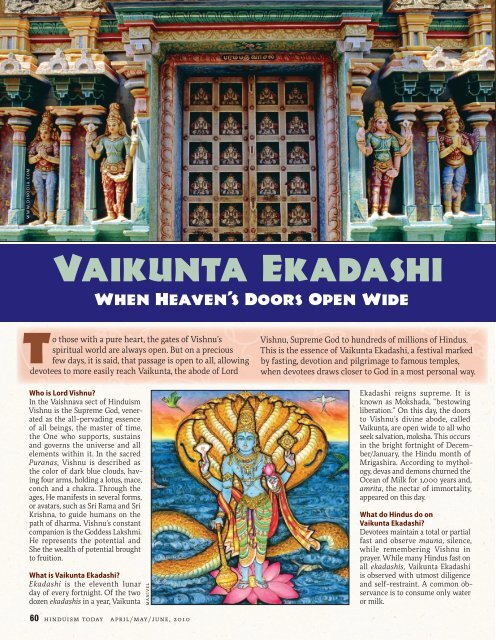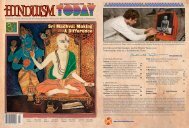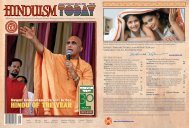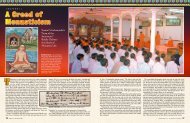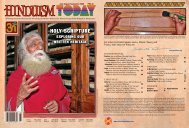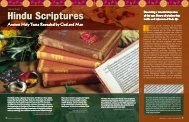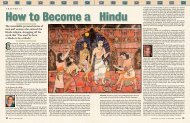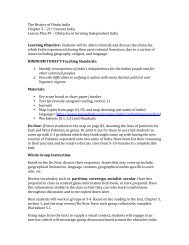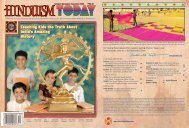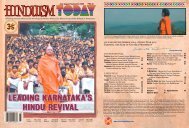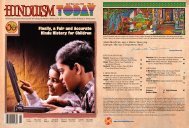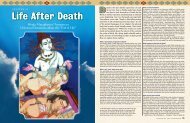Download PDF: Two-Page, Full-Color Magazine Spread - Hinduism ...
Download PDF: Two-Page, Full-Color Magazine Spread - Hinduism ...
Download PDF: Two-Page, Full-Color Magazine Spread - Hinduism ...
Create successful ePaper yourself
Turn your PDF publications into a flip-book with our unique Google optimized e-Paper software.
www.dinodia.com<br />
Vaikunta Ekadashi<br />
When Heaven’s Doors Open Wide<br />
T<br />
o those with a pure heart, the gates of Vishnu’s<br />
spiritual world are always open. But on a precious<br />
few days, it is said, that passage is open to all, allowing<br />
devotees to more easily reach Vaikunta, the abode of Lord<br />
Who is Lord Vishnu?<br />
In the Vaishnava sect of <strong>Hinduism</strong><br />
Vishnu is the Supreme God, venerated<br />
as the all-pervading essence<br />
of all beings, the master of time,<br />
the One who supports, sustains<br />
and governs the universe and all<br />
elements within it. In the sacred<br />
Puranas, Vishnu is described as<br />
the color of dark blue clouds, having<br />
four arms, holding a lotus, mace,<br />
conch and a chakra. Through the<br />
ages, He manifests in several forms,<br />
or avatars, such as Sri Rama and Sri<br />
Krishna, to guide humans on the<br />
path of dharma. Vishnu’s constant<br />
companion is the Goddess Lakshmi.<br />
He represents the potential and<br />
She the wealth of potential brought<br />
to fruition.<br />
What is Vaikunta Ekadashi?<br />
Ekadashi is the eleventh lunar<br />
day of every fortnight. Of the two<br />
dozen ekadashis in a year, Vaikunta<br />
manivel<br />
Vishnu, Supreme God to hundreds of millions of Hindus.<br />
This is the essence of Vaikunta Ekadashi, a festival marked<br />
by fasting, devotion and pilgrimage to famous temples,<br />
when devotees draws closer to God in a most personal way.<br />
Ekadashi reigns supreme. It is<br />
known as Mokshada, “bestowing<br />
liberation.” On this day, the doors<br />
to Vishnu’s divine abode, called<br />
Vaikunta, are open wide to all who<br />
seek salvation, moksha. This occurs<br />
in the bright fortnight of December/January,<br />
the Hindu month of<br />
Mrigashira. According to mythology,<br />
devas and demons churned the<br />
Ocean of Milk for 1,000 years and,<br />
amrita, the nectar of immortality,<br />
appeared on this day.<br />
What do Hindus do on<br />
Vaikunta Ekadashi?<br />
Devotees maintain a total or partial<br />
fast and observe mauna, silence,<br />
while remembering Vishnu in<br />
prayer. While many Hindus fast on<br />
all ekadashis, Vaikunta Ekadashi<br />
is observed with utmost diligence<br />
and self-restraint. A common observance<br />
is to consume only water<br />
or milk.<br />
60 hinduism today april/may/june, 2010
www.dinodia.com<br />
What are the temple observances?<br />
Devotees flock to Vishnu shrines, especially<br />
famous ones such as the Venkateshwara<br />
temples in Tirupati and Pittsburg, and the<br />
Ranganathar temple in Srirangam. In Srirangam<br />
the festival spans 21 days divided<br />
into morning and night observances. Lord<br />
Vishnu, adorned in diamond-studded armor,<br />
is brought to a 1,000-pillared hall<br />
through the northern gate, called swarga<br />
vaasal, “heaven’s entrance,” which is<br />
opened only this one time each year.<br />
apple What is the legend of Ekadashi? In an<br />
ancient story, Ekadashi is a devi, or angel,<br />
born of Vishnu’s mind, a fierce defender<br />
of righteousness, a protectress of those in<br />
need. Strengthened by unfailing devotion<br />
to God Vishnu, she was feared by the forces<br />
of evil and ignorance. Vishnu offered<br />
her the boon of being rich,<br />
famous, powerful and beautiful in<br />
the world of mortals. But she declined,<br />
saying she wanted only to<br />
share her blessings with humans<br />
who fast and pray to Him on ekadashi.<br />
Vishnu granted her wish,<br />
decreeing that anyone worshiping<br />
Him by fasting on the eleventh day<br />
of the moon would be allowed access<br />
through the celestial gates. In<br />
the epic Maha bharata, Lord Krishna<br />
relates Ekadashi’s story to King<br />
Yudhishthira, praising her and recommending<br />
fasting as an ancient<br />
and effective spiritual practice.<br />
What else is celebrated around this time?<br />
In the northern hemisphere, winter solstice occurs<br />
in this month, heralding longer, warmer<br />
days and agrarian prosperity. This transition<br />
to the year’s fortuitous half is celebrated with<br />
beautiful patterns, called rangoli, drawn with<br />
colored rice flour on the floor outside homes.<br />
Hindus believe that at this time the divine celestials<br />
are most attentive to the pleas of mankind.<br />
Devotees rise early, perform ablutions<br />
and, throughout the month, visit temples with<br />
prayers in heart and gifts in hand.<br />
Tidbits About Vaikunta Ekadashi<br />
apple How is the fast broken? The Ekadashi fast is<br />
normally broken the next lunar day, dvadashi,<br />
by partaking of fruit, herbs and milk. The Indian<br />
gooseberry, amla, known as a wonder food,<br />
is eulogized in the Puranas as the ideal nourishment<br />
to jump-start the system after a fast.<br />
<strong>Hinduism</strong>: Fact & Fiction<br />
Does Religious<br />
Fasting Make Sense?<br />
Fasting in <strong>Hinduism</strong> indicates the denial<br />
of the physical needs of the body for<br />
the sake of spiritual gains. According to<br />
scripture, fasting helps create an attunement<br />
with the Absolute by establishing<br />
a harmonious relationship between<br />
the body and the soul. By fasting, the<br />
devout exercise control over their rioting<br />
senses and desires. It is a sacrifice<br />
made to the Self, by the self.<br />
By turning within in meditation, they<br />
rein in the mind. Since the body<br />
is mostly composed of fluids, it is<br />
influenced by the phases of the moon,<br />
as is the mind. The rishis, ancient<br />
Hindu scientists, established these<br />
connections and recommended fasting<br />
and meditation based on the moon<br />
cycle, such as on ekadashi. This causes<br />
a natural slow down of the system and<br />
the opportunity to reconnect with one’s<br />
deeper being.<br />
Fasting breaks life’s repetitious regimen<br />
and brings clarity, empowering the<br />
individual to resume normal activities<br />
with greater vigor and conviction.<br />
FACT: Science and mysticism have long blended in Hindu tradition. The ancient sages who wrote<br />
the scriptures also made observations on astronomy, time and mathematics. Long before Galileo,<br />
Copernicus and Newton, Hindus recorded knowledge of gravity, heliocentrism and other universal<br />
laws in treatises called Siddhanta. Hindu rishis further explored the connections between mind,<br />
body and the soul, evolving the sciences of yoga and ayurveda for a rewarding, beneficial life.<br />
FICTION: Western scholars describe <strong>Hinduism</strong> as polytheistic. This is incorrect. While Hindu<br />
scriptures speak of many Gods—as many as 330 million—there is only one Supreme Being, which<br />
Hindus of various denominations and linguistic backgrounds worship by different names. The<br />
One Great God created lesser Divinities, suprahuman beings presiding over aspects of Creation,<br />
not unlike the archangels of Christianity. <strong>Hinduism</strong> is neither polytheistic nor pantheistic; its<br />
philosophy is rightly called panentheism, God in all things and yet beyond.<br />
dreamstime<br />
april/may/june, 2010 hinduism today 61


